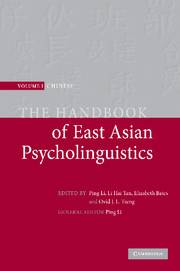Book contents
- Frontmatter
- Contents
- List of figures
- Notes on contributors
- Preface
- Introduction: new frontiers in Chinese psycholinguistics
- Part I Language acquisition
- 1 Actions and results in the acquisition of Cantonese verbs
- 2 Chinese children's knowledge of the Binding Principles
- 3 Chinese classifiers: their use and acquisition
- 4 Child language acquisition of temporality in Mandarin Chinese
- 5 Second language acquisition by native Chinese speakers
- 6 Making explicit children's implicit epilanguage in learning to read Chinese
- 7 Emergent literacy skills in Chinese
- 8 Basic syntactic categories in early language development
- 9 Growth of orthography-phonology knowledge in the Chinese writing system
- 10 Interaction of biological and environmental factors in phonological learning
- 11 The importance of verbs in Chinese
- 12 Grammar acquisition via parameter setting
- 13 Early bilingual acquisition in the Chinese context
- Part II Language processing
- Part III Language and the brain
- Epilogue: a tribute to Elizabeth Bates
- References
- Name index
- Subject index
5 - Second language acquisition by native Chinese speakers
Published online by Cambridge University Press: 05 June 2012
- Frontmatter
- Contents
- List of figures
- Notes on contributors
- Preface
- Introduction: new frontiers in Chinese psycholinguistics
- Part I Language acquisition
- 1 Actions and results in the acquisition of Cantonese verbs
- 2 Chinese children's knowledge of the Binding Principles
- 3 Chinese classifiers: their use and acquisition
- 4 Child language acquisition of temporality in Mandarin Chinese
- 5 Second language acquisition by native Chinese speakers
- 6 Making explicit children's implicit epilanguage in learning to read Chinese
- 7 Emergent literacy skills in Chinese
- 8 Basic syntactic categories in early language development
- 9 Growth of orthography-phonology knowledge in the Chinese writing system
- 10 Interaction of biological and environmental factors in phonological learning
- 11 The importance of verbs in Chinese
- 12 Grammar acquisition via parameter setting
- 13 Early bilingual acquisition in the Chinese context
- Part II Language processing
- Part III Language and the brain
- Epilogue: a tribute to Elizabeth Bates
- References
- Name index
- Subject index
Summary
English is the second language most widely learned by Chinese speakers in their native countries or overseas. This chapter focuses on the psycholinguistic research on the learning of English by native Chinese speakers who are immigrants in English-speaking countries. In comparison to English learners in their native countries, English learners in immigration settings experience a more variable English environment, and thus tend to exhibit larger individual differences in their learning speed and the proficiency level they attain in the long run. Therefore, studying English acquisition in immigration settings allows researchers to more fully document the processes by which language proficiency changes, identify persistent linguistic problems, and better understand the factors that impact on language proficiency.
Research on Chinese speakers learning English in immigration settings has been embedded in the larger field of second language (L2) acquisition in which many other native language groups are studied. This line of research has two related goals. The first is to obtain a comprehensive description of the L2 acquisition processes. Such a description involves the growth trajectories of L2 proficiency in different linguistic components (e.g. phonology, lexicon, morphosyntax) and how they vary among L2 learners of different ages. As first language (L1) proficiency also changes along with L2 acquisition in immigration settings, a recent advance in the field is to include L1 proficiency change in the same picture. The second goal is to identify the factors impacting on L2 acquisition.
- Type
- Chapter
- Information
- The Handbook of East Asian Psycholinguistics , pp. 61 - 69Publisher: Cambridge University PressPrint publication year: 2006
- 1
- Cited by



